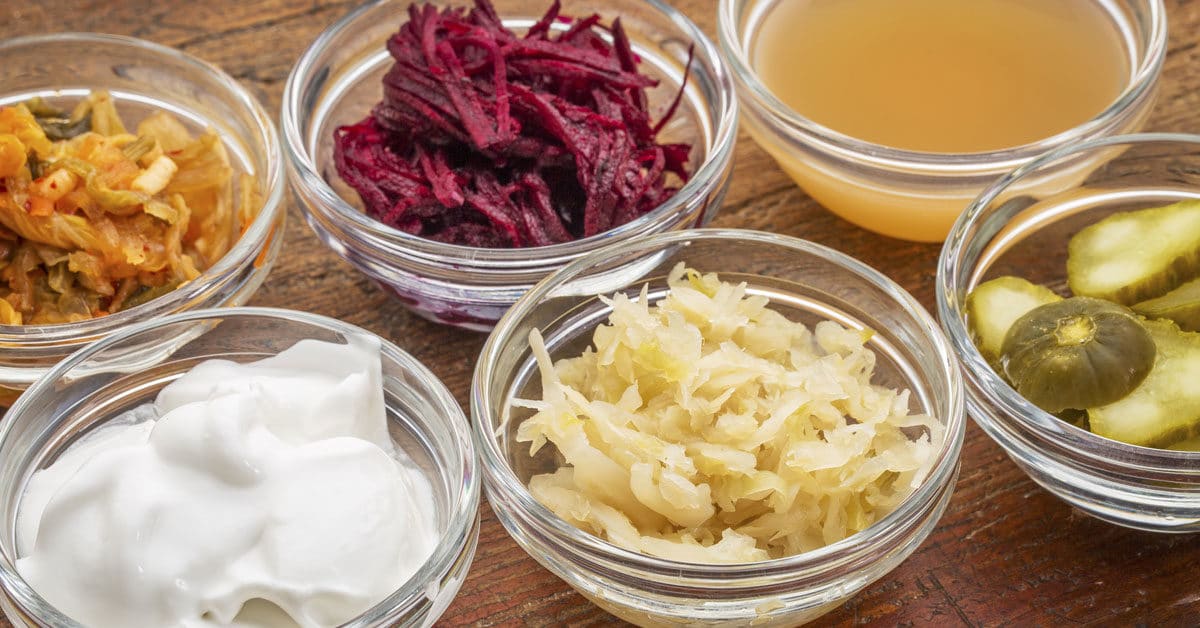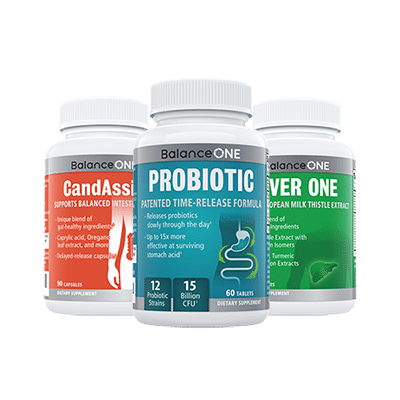Foods To Improve Your Gut Health: Prebiotics, Probiotics & More

When your digestive issues are making you bloated, sore, and uncomfortable, trying new foods may seem like the last thing you want to do! But there are certain foods that are amazingly good for improving your gut health and digestion.
Believe it or not, there’s a huge range of foods out there that can not only help to ease acute digestive symptoms, but also help to restore the health of your gut. It’s all about knowing which ones contain the vital nutrients and probiotics you need.
Studies have shown that one of the main factors influencing the diversity of gut microbiota is diet. For optimal health, your body needs nutrients and probiotics from the foods you eat.
The good news is that these gut-healing foods are delicious, readily-available and can often be made in your own kitchen!
Table Of Contents
Prebiotic Foods
Prebiotics are the ‘food’ for the good bacteria in your gut. Prebiotics help to maintain healthy conditions in the gut by producing fermented by-products that other microbiota can feed on. It’s a good idea to include both prebiotics and probiotics in your diet to keep all those bacteria happy.
The best prebiotic foods are those that contain inulin, an insoluble fiber. Inulin works by helping move food through the body from the small intestine to the colon. In the colon, inulin naturally ferments and produces energy for microflora to live on. The list of foods to eat on the Candida diet contains lots of prebiotic foods.
The Best Sources of Prebiotics
- Asparagus
- Bananas
- Chicory
- Garlic
- Dandelion greens
- Jerusalem artichoke
- Kiwifruit
- Legumes (chickpeas, beans)
- Leeks
- Onions
Probiotic Foods / Fermented Foods
Fermented foods are those which are technically ‘raw’, but are rich in beneficial bacteria and easy-to-absorb nutrients. This is because they’ve been naturally fermented by bacteria – the same way bacteria break down food in your gut. Because of this, these foods are already broken down when you eat them, making them both easier to digest AND a fast way to deliver probiotics to your gut.
Fresh bacteria in these fermented foods help to improve the diversity of the microbiota in your gut, as well as helping your ‘resident’ bacteria work more efficiently.
Fermented foods have the power to reduce inflammation in the gut, improve your microbiota profile, improve digestion and the absorption of minerals, and even improve mental health.
Probiotic Foods Can Help To
- Strengthen the immune system
- Improve digestion
- Boost energy production due to higher levels of vitamin B12
- Reduce pathogenic bacteria and yeast such as Candida albicans
- Reduce bad breath caused by poor gut health
- Heal leaky gut
- Reduce inflammation
- Improve skin health
The living microorganisms in many fermented foods are genetically similar to strains included in supplements. Just add some fermented foods to your normal meal for a powerful probiotic boost! Now let’s take a look at some probiotic foods.
Best Sources of Probiotic Foods
Fermented vegetables are an excellent source of live microorganisms. Sauerkraut is a traditional European dish made from fermented cabbage, carrots, and other vegetables. In Korea, a similar dish called kimchi is also popular, and usually contains a lot of chili. Both kimchi and sauerkraut should be eaten fresh (not canned!) to provide a live dose of bacteria and digestive enzymes to the gut.
Fermented soybean products such as natto, miso, and tempeh form the basis of the Japanese diet and are often credited with improving their longevity.
Natto is a particularly popular health food thanks to its high content of Bacillus subtilis, a scientifically-researched probiotic which has been found to boost the immune system, improve digestion and enhance the breakdown of vitamin K2. Natto also contains a potent anti-inflammatory enzyme called nattokinase, which reduces gut inflammation and supports healing processes.
Naturally cultured dairy: yogurt, kefir
Non-dairy cultured products: coconut yogurts, water kefir
Fermented drinks: kefir, kombucha
Fermented condiments: raw apple cider vinegar with the ‘mother’
Gut Healing Foods
Bone Broth
This ancient food has been used for centuries to heal ailments of all kinds. It’s rich in nutrients, highly digestible, full of flavor, and the best thing for a sore, inflamed gut.
Bone broth often includes the bones, marrow, skin, tendons, and ligaments of an animal. These parts are boiled together like a soup, then simmered for 1-3 days. Simmering allows the bones and other parts to release their nutrient-dense compounds into the broth – such as collagen, proline, glycine, and glutamine. These incredible nutrients help to heal a damaged or inflamed gut lining by restoring cell junctions and nourishing the epithelium.
Because the minerals in bone broth are in a form that your body can readily absorb, drinking it is a fast and effective way to heal leaky gut. Nutritional researchers recommend bone broth as a rich source of calcium, magnesium, phosphorus, silicon, sulfur and other vital minerals. These nutrients help to reduce inflammation and support the growth of new cells.
Oily Fish
Wild oily fish are a rich source of Omega 3 fatty acids, the most important of all fats. Every cell in your body requires healthy fat to function – and none so more than the cells lining the walls of your gut! Omega 3 is also a powerful anti-inflammatory, helping to soothe irritation in the intestines and set the stage for healthy new cells to form.
The best fish to include in your Candida diet are salmon, mackerel, sardines, anchovy, and halibut. Try to have at least 2-3 servings per week to reach optimal Omega 3 intake.
Turmeric Latte
Also known as ‘golden milk’, the turmeric latte has become one of the hottest health drinks of the decade! Turmeric is renowned for its proven anti-inflammatory properties, especially in intestinal disorders such as leaky gut. Turmeric is also believed to combat pathogenic bacteria in the gut and help heal gut permeability by drawing together junctions between cells in the gut wall.
The trick to accessing turmeric’s therapeutic properties is to take it with healthy fat and black pepper. The fat and piperine are required to make the turmeric bioavailable so that it can be absorbed by the body.
That’s how the turmeric latte came about: it’s a concoction of high-fat coconut milk (high in healthy fats, that is!), black pepper and turmeric. Taken together as a warming drink, this formula can help to heal an inflamed gut and restore healthy microbial balance. And it’s delicious, too!
Restore Your Gut With The Right Foods
Healing your gut begins with eating the right foods. You don’t necessarily have to seek out expensive supplements or make drastic life changes: simply include any of all of the above foods in your diet as often as possible.
When done right, you’ll notice that your bloating subsides and your digestion improves: this is a sure sign that your microbiota is getting back in balance and your gut lining is stronger. You’ll also find that you actually WANT to keep eating these foods, as your body will respond to their amazing health properties.
If you’re interested in learning more about eating a non-inflammatory diet and lifestyle that will help to beat your Candida, check out our Ultimate Candida Diet program. After all, what’s better than eating your way to good health?

3-Month Candida Elimination Kit Start Your 3-month Candida Cleanse
This Candida Kit contains all the supplements recommended on the Candida Diet:
- LIVER ONE to process and remove the toxins created by Candida.
- CANDASSIST to inhibit and weaken the Candida colonies in your gut.
- PROBIOTIC to replace the Candida yeast with probiotic bacteria.
Plus... the CANDIDA DIET RECIPE BOOK with 50+ low-sugar recipes

Many thanks for your great professional assistance in the field of health, candida, etc.
Best wishes,
Damian Riviez, Ph.D.